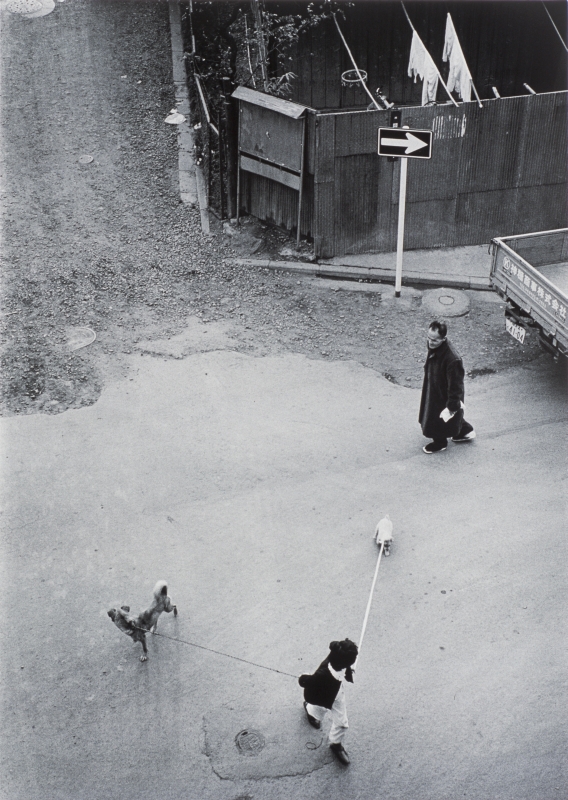Transient, Fleeting: The World of Ishimoto Yasuhiro part 15

“The Course of Nature” and “Thorough Pursuit”
After returning to Japan from his second stay in Chicago, Ishimoto began to teach at the Tokyo College of Photography and Tokyo Zokei University among others, while continuing to roam his everyday life environments in the Tokyo and Fujisawa areas, and observe people’s daily activities, just like he used to do back in Chicago. Even without particularly dramatic happenings, there are minute shifts that instantly occur in the otherwise largely static everyday, and this photograph has to be one of those works that capture such moments.
Ishimoto doesn’t like taking commissioned pictures of people posing for him. That’s because of his idea that, if one just waits and leaves things up to nature, magnificent sceneries beyond imagination will incidentally appear right before one’s eyes. “Giving any kind of instruction always involves knowing your own limits, whereas leaving things up to nature yields results that exceed your own ability, so this is a more rewarding approach.” The instinct and sensitivity not to miss the crucial moments within the course of nature is something one can particularly sense also from the Tokyo sceneries captured in Ishimoto’s photos. In addition to this, there are obvious traces of the curriculum of the New Bauhaus that thoroughly honed Ishimoto’s skills.
When looking at this particular photo, I remembered hearing about lessons at the New Bauhaus, where students were made to draw dots with a pencil on paper first, and then draw connecting lines between them. The idea was to discover the attractive forces between dots that exist even without connecting lines, and how those forces’ intensity changes in proportion to the distances between the dots. In this work, combinations of straight lines that affect each other in various directions generate a magnetic field inside the picture. If you try and draw arrows visualizing the directions of the forces that you recognize, such as the movements of the girl and the dogs, and the man’s gaze, you will notice the entanglement of all kinds of directional forces, including of course also the arrow in the traffic sign. The mellow everyday scene of a girl trying to keep her dogs that both have other things in mind under control, and a man walking by casually, is charged with an exquisite sense of tension caused by the attractive forces that connect individual points within the picture, and the power that extends to the outside of it.
Around the time this photo was taken, Ishimoto was instructing amateur photographers in a certain rural area, and gave them the following message and advice. ”When looking for a subject, we generally tend to bypass the things that are right in front of us. I’d like you to take another look at the things around you that you are usually taking for granted. There you will surely find plenty of things that are worth capturing, and I think that’s where the characteristics that are unique to certain people and certain places arise from.” “When working with a camera, focus on the aspects of lens, shutter and focusing one by one, and thoroughly explore the possibilities that emerge from each of these mechanisms.” (Asahi Camera, 1965)
Being on the lookout in everyday life, and placing importance on the course of nature and the thorough pursuit of things – this is what defines the style of Ishimoto’s photography.
(Published on June 6, 2006)
Kageyama Chinatsu, curator at the Museum of Art, Kochi
Ishimoto Yasuhiro Photo Center

